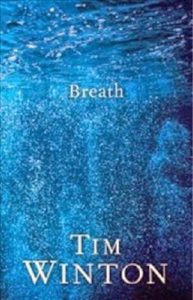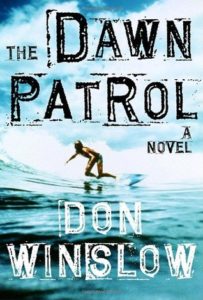I’m not much on providence—the idea that there’s some kind of master plan to the cosmos seems optimistic to me. I think life happens in the way it happens like marbles might spill out of a bag across a cement floor. Without much rhyme or reason beyond crazy rebounds and the basic physics of cause and effect.
But I have to confess that thirty years ago I had become consumed with surfing and its culture after reading Kem Nunn’s brilliant Tapping the Source—a life-changing novel about a desert town teenager who hitchhikes to Huntington Beach (Surf City, USA) to find his missing sister, only to get caught up in the drug-edgy SoCal surf culture.
Kem Nunn is probably the closest thing “Surf Noir” literature has to a founding father, and the irony that I’m writing this after surfing the morning session at Playa Negra is not lost on me.
If it weren’t for Kem Nunn I wouldn’t be a surfer. I would not have written a novel about an expat hiding out and surfing South of the Border and I certainly wouldn’t be writing an article about “surf noir,” from Costa Rica no less. I’m down here on a surf safari with my twelve-year old son. We’re a surfing family, the four of us. Surfing determines where we live—and it was a big part of the reason I quit the 24-7 madness of Hollywood.
When it was time to put our daughter in a US high school, we moved back up from Mexico to Southern California. Our one criterion for house hunting was that our new digs be close to a serious surf break. We now live just up the road from Swami’s.
To bring that surfing synchronicity full-circle, Kem Nunn blurbed Pirata. My surf noir literary hero endorsed the novel I wrote after being inspired to surf after reading Tapping the Source. Perhaps there are times when the marbles ricochet with purpose. If there’s any order in the universe, maybe it lines up with the passion surfers find paddling out—Kem Nunn is a surfer. Or maybe surfing a good wave can give you the feeling that life makes sense, at least for those few fleeting seconds.
When I’d first devoured Tapping the Source, I thought, “This is the kind of life I want to live.” Not with the murder and mayhem, of course, but close to the ocean and the apparent magic of surfing. I determined to read everything I could get my hands on about surfing and surf culture.
But here’s the problem, when it comes to reading about surfing, there’s not much swell. Which is a drag because most of the surfers I know read a lot—it gives us something to do while waiting for waves instead of scanning weather blogs and buoy reports. If Surf Noir were a wine its blood red bottled grapes couldn’t fill a single shelf in a modest wine closet.
In three months I’d read nearly the entire library of surf literature—about five books, give or take: Nunn’s fabulous second and third novels—Dogs of Winter and Tijuana Straits. Tim Winton’s amazing Breath, and Don Winslow’s delicious surf world sagas.
Apart for some pretty incredible non-fiction, notably Bill Finnegan’s Pulitzer Prize winning Barbarian Days and the gonzoish Welcome to Paradise; Now Go to Hell by BeachGrit’s Chas Smith and Allan Weisbecker’s must read In Search of Captain Zero, there aren’t a lot of worthy tomes stacked on the coffee crate at the beach shanty.
The North Shore Chronicles is worth a read, as is Caught Inside—but getting a PhD in Surf Lit won’t take an Endless Summer. (Although, make sure you watch that documentary, along with Riding Giants.)
The tricky thing with surf literature (applying literature in its most forgiving form) is that you have to know a little about surfing to appreciate it. Which means the writer has to educate the newbie without sounding like a kook to the surfer aficionado. Kook, by the way, if you don’t know, means a person who pretends to know about surfing but who really doesn’t. See?
Surf culture is uniquely complicated. It’s not for dilettantes. The best depiction I’ve heard of what it takes to be a surfer is this: surf one hundred and fifty days in a row, big swell or small, and catch at least five waves a day—however long it takes to catch those five waves, from sunup to sundown. At the end of those one hundred and fifty days you will be a beginner—from then on surf at least one hundred days a year. At the end of ten years, if you are dedicated, you might not be a kook and you can call yourself a serious surfer. Maybe.
The best depiction I’ve heard of what it takes to be a surfer is this; surf one hundred and fifty days in a row, big swell or small, and catch at least five waves a day…At the end of those one hundred and fifty days you will be a beginner.”I pretty much followed that formula, to the extent that it took me ten years to even consider a novel that took place in the world of surfing and then another four years to write it. The sound of waves crashing onshore just down the calle from our casa in Sayulita would yank me off the keyboard. I’d grab my board and be gone—pretending I was “still researching” but never had a sport meant so much to me. Missing makeable waves is painful. Probably because it’s not really a sport—it’s a way of life. Surfing isn’t something you do on vacation. It’s not zip lining.
If writers who write about surfing surfed less there’d probably be more books about surfing… but maybe not that delectable surf noir. The novels might not be as good, the insight as keen or the culture as nuanced.
Surfing has become a “thing” now. A brand—with water cooler bragging rights and horror stories about rip currents and banditos on the beach. But let’s see who’s still around after those first one hundred and fifty days—and then that decade surfing ten days a month.
Here’s a handy quiz—if someone tells you they’re a surfer, ask them if they’ve read Tapping the Source or Breath or Barbarian Days… and if they answer yes, I can just about guarantee you that they’ve put in the time… and can paddle out on an overhead day.




















